Here’s a wealth of information about HYACINTHS from our email Gazette and past catalogs, starting with the most recently published. For other topics, please see our main Newsletter Archives page.
To subscribe to our FREE email newsletter, click here.
For a complete history of hyacinths — from wild hyacinths through ancient times, the Ottoman Empire, the court of Madame Pompadour, and the Victorian age — see “The Hyacinth Story”.
To learn how to force hyacinths — including our impossibly easy, paper-bag-in-the-fridge technique — see our Forcing Bulbs page.
Blooming Now: The National Collection of Hyacinths on YouTube
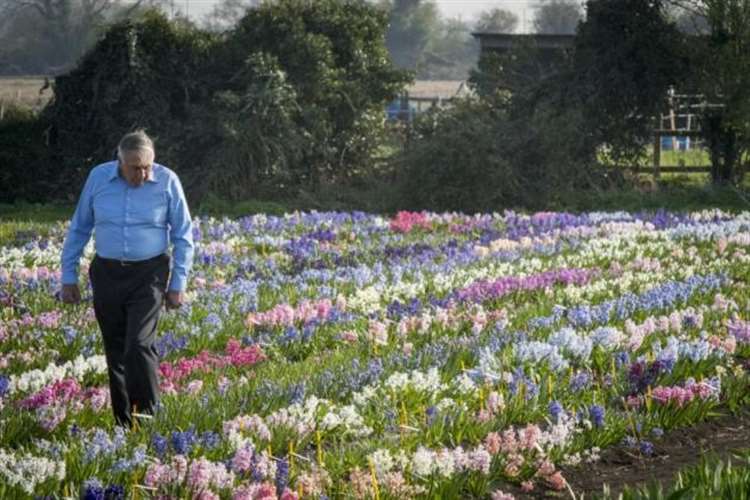
With his April open house cancelled due to Covid-19, our good friend Alan Shipp has posted a short video-tour of his hyacinth fields on YouTube.
Although the eight-and-a-half-minute clip is more of a home-movie than a polished production, it’s a treat to see Alan – who’s been called the Noah of hyacinths – walking through his endless rows of hyacinths and chatting about this variety and that almost as if they were his grandchildren.
You can walk with him here – and then if you’re feeling inspired, check out the 14 hyacinths we’re offering now for delivery this fall, and stay tuned for more to follow this summer from Noah himself. (April 2020)
Multiplying Hyacinths in 1896 and Today
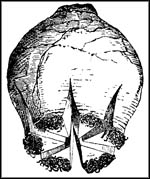
Daffodils, tulips, and most other bulbs multiply naturally underground by producing offsets or daughter bulbs. Roman hyacinths do, too, but – after centuries of breeding – traditional garden hyacinths reproduce so slowly this way that bulb growers long ago developed ways to speed up the process. The techniques described below by Liberty Hyde Bailey in his 1896 Nursery Manual would have been familiar to bulb-growers a century earlier and are still standard practice in the Netherlands today.
Bailey starts by explaining that “bulbels are often produced by an injury to the bulb. Growth of stem and leaves is more or less checked and the energy is directed to the formation of minute bulbs.” It’s the bulb’s natural reaction to injury that growers take advantage of in multiplying hyacinths.
“The favorite method is to make two or three deep transverse cuts into the base of the bulb [image 1]. The strongest bulbs should be chosen, and the operation is performed in spring or early summer, when the bulb is taken up.”
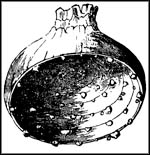
In another method, “the bulbs are hollowed out from the underside for half or more of their depth [image 2]. This operation is sometimes performed later in the season than the other, and precaution should be exercised that the bulbs do not become too moist, else they will rot. . . .
“The mutilated bulbs are stored during summer, and are planted in fall or spring. The wounded bulbs produce very little foliage, but at the end of the first season the bulbels will have formed. The bulbels are then separated and planted by themselves in prepared beds.
“Several years are required for the bulbels to mature into flowering bulbs. Some of the strongest ones may produce flowering bulbs in three years, but some of them, especially those obtained from the hollowed bulbs, will not mature short of six years.”
Could you do this at home? Of course – and now’s the time for it. If you do, please share your story (and photos) with us. Good luck, and have fun! (June 2018)
Heirloom Gardener Spotlights the “Noah of Hyacinths”
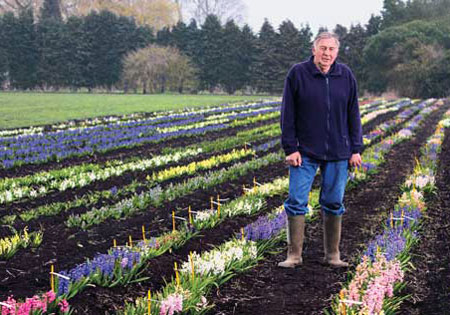
Our good friend Alan Shipp and his ark of hyacinths are featured in the fall 2017 issue of Heirloom Gardener magazine. Editor Rebecca Martin tells the inspiring story of how Alan, a third-generation vegetable farmer, became the world’s leading expert on historic hyacinths and guardian of some 250 rare varieties.
Nine of Alan’s treasures are pictured in the article, and if some of the photos look familiar it’s because you’ve seen them at our website. As Rebecca writes, shortly after Alan sold his first hyacinths he started exporting bulbs to “Scott Kunst, founder of Old House Gardens, who’s also passionate about saving old cultivars. OldHouseGardens.com is a Michigan mail-order company specializing in heirloom flower bulbs, and the exclusive U.S. dealer for Alan’s hyacinths. ‘There’s nothing like a phone call from Alan, out of the blue, telling me about some exciting new hyacinth he’s found,’ Scott says. ‘It’s like the sun suddenly bursting out of the clouds on a beautiful spring day. He’s truly an inspiration and a world treasure.’”
You can read the entire article – and explore Heirloom Gardener magazine – at heirloomgardener.com/profiles/people/heirloom-bulbs-zm0z17fzmar. Although all of Alan’s hyacinths are sold out this fall, seven other fabulous, fragrant heirloom hyacinths are still available – if you order now! (Oct. 2017)
Lonely “Leftover” Survives, Blooms, Wins
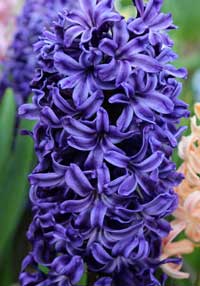
“Bulbs want to grow.” That’s what we say here at Old House Gardens whenever we hear a story like this one sent to us recently by our good customer Anita Bischoff of Kings Park, NY:
“In January, I found one ‘Marie’ hyacinth bulb lying in my garage. I must have dropped it when I planted the other 24 last fall. I put it in a glass forcing vase and then into my wine fridge. When green sprouted from the top, I put it on a windowsill. It looked beautiful as it was growing and it bloomed just in time to win a FIRST prize at the Smithtown Garden Club meeting last week – so all was not lost for the leftover. Happy Easter!” (April, 2016)
Customer Raves: Hooray for Hyacinths!
Although once the most popular bulb of all, hyacinths are rarely found in most gardens today. If you’re not growing them, you’re missing something special — as these fans will tell you:
Writing in Horticulture magazine, our good friend Marty Ross of zone-6a Kansas City, MO, tells of planting hyacinths “here and there in groups of three or five, almost like wildflowers. The soft pink ‘Lady Derby’, which has been around since 1875, is one of the prettiest, and it has persisted in my garden for years. I grow it among epimediums, hardy begonias, and a splashy variegated hosta; they hide the hyacinth foliage when it flops over in late spring.”
Double ‘General Kohler’ “keeps on multiplying,” our long-time customer Donna Mack writes us from zone-5b Elgin, Illinois. “Every year I have more, and the bulbs are huge. I think you’re right that they like being dry in summer. I have them planted among ornamental grasses — they’re lovely there when the grasses are cut down in spring — and that area has a low priority when it comes to watering. You should see them! Every spring more and more appear. This past spring, I must have had half a dozen new ones.”
And in Slow Flowers: Four Seasons of Locally Grown Bouquets, Debra Prinzing of zone-8b Seattle recommends making small, multi-colored bouquets of nothing but hyacinths. “A singular sensation — for the eye as well as the nose — hyacinths are so stunning that it’s hard to justify pairing them with any other flower. In fact, you really only need one hyacinth bulb, cupped in a special forcing glass, to experience the arrival of spring on your windowsill. . . . When I brought home a mixed bunch from the farmers’ market, they filled my car with a heady perfume.”
See for yourself by ordering a few of our 15 awesome hyacinths (several of which are on sale at 10-15% off) or our easy Easter Basket sampler now! (Oct. 2015)
Extinct No More: Last “Eyed” Hyacinth Rediscovered in Romania
“What really is extinct?” our good friend Alan Shipp asks in the fall 2014 journal of Plant Heritage, the UK’s non-profit devoted to conserving garden plants. “The coelacanth was considered to be extinct,” he writes. “The ‘fossil pine’ was only known by its fossilized remains.” And then Alan tells of another exciting rediscovery.
Although originally considered inferior, double hyacinths came into vogue in the early 1700s after one breeder discovered a double white that had “red” petals in the center of each floret. “Eyed” hyacinths with other contrasting colors were soon developed, fueling a Hyacinth Mania in the 1730s — but, as Alan writes, “we considered all of these extinct many, many years ago.”
Recently, though, “a lady called Ingrid living in Switzerland had a lorry driver friend called Theo. Theo and a fellow driver took a lorry load of humanitarian aid to a remote little village in Romania where Theo’s friend met, courted, and eventually wed a local girl. Theo returned to the village for the marriage, and so splendid was the hospitality that Theo gave the bride’s father a pocket watch.” In return, the father invited Theo to “take anything he wished from the garden. Theo selected a hyacinth bulb labeled ‘Gloria Mundi’ and on his return to Switzerland gave the bulb to his gardener friend Ingrid.
“Very fortunately for the plant world, Ingrid passed it on to Alan Street of Avon Bulbs who [eventually] gave two small bulbs to me for the Hyacinth National Collection. . . . ‘Gloria Mundi’ was illustrated in 1767, and a pot of ten small bulbs in bloom was this spring awarded an RHS Certificate for Plants of Historic or Botanical Interest.
“Footnote: The garden in Romania has been located and visited this past April. The old man is dead and his son has dug up all flowers to grow vegetables. Saved just in the nick of time one might say!”
See ‘Gloria Mundi’ here, and then while we wait for Alan to increase and share it with us, why not enjoy a few of our other fabulous hyacinths, both doubles and singles, which are all on sale now. (Nov. 2014)
Tulsa Garden Writer Swoons for “Spicy” ‘Madame Sophie’
Our good friend and long-time Tulsa garden writer Russell Studebaker emailed us a few months ago, agitated about a certain double white hyacinth that we offer:
“I want to tell you how ticked off I was when I tried to order ‘Madame Sophie’ again from you last fall and you were sold out! I LOVE THAT HYACINTH. It has the most spicy and wonderful fragrance of any of the hyacinths that I have grown, and its flowers persisted and lasted so long for me. I cannot image why it has become so endangered and hard to find. Since you were sold out so early in the season, I had to go on my search engine and after a great while I did get some out of England, at a premium price. But what the heck, things of beauty and quality are worth the extra cost. Please order more for this fall, and find additional growers for that superb hyacinth.”
Some might say it’s wrong to love a plant that much, but we’ve been there, and we understand. Could ‘Madame Sophie’ inspire such passion in your garden-heart? To find out, all you have to do is order a few for planting this fall. Russell, we’re happy to say, already has. (July 2014)
Stone Bouquet: 17th-Century Tulips, Roman Hyacinths, and Crown Imperial
A friend sent us a notecard recently with a striking image of tulips, Roman hyacinths, and crown imperial, all worked out in semi-precious stones. Dating to the second half of the 1600s, the artwork is an example of pietra dura, an expensive, mosaic-like inlay made with thin slabs of stones such as jasper, malachite, and lapis lazuli. Now in the collection of Nelahozeves Castle in the Czech Republic, the artwork shows flowers that were new and expensive at the time — and so little changed since then that they are instantly recognizable today — including a crown imperial, sparsely-flowered Roman hyacinths, and a tulip that looks a lot like ‘Lac van Rijn’. See it here. (late Oct. 2013)
Fragrant, Colorful, Historic . . . and Hard to Spell
Once America’s favorite bulb — the one at the front of every catalog, with more varieties offered than even tulips — hyacinths have plummeted in popularity over the past 150 years. Could spelling be to blame? Gardeners searching for hyacinths at our website have misspelled it and its Latin name hyacinthus 38 different ways, more than just about any other bulb.
But don’t worry. Gardening isn’t a spelling bee, and whether you spell it hiacinth, hiacynth, hiasinth, hyacenth, hyachinth, hyacin, hyacincth, hyacisth, hyacith, hyacynth, hyacynthe, hyancinth, hyancith, hyacint, hyacunth, hyascinth, hyasenth, hyasinth, hycainth, hycianth, hycienth, hycieth, hycinth, hycient, hycieth, hycient, hycinth, hyinth, hyncinth, hacynthas, hyacinthas, hyacinthis, hyacynthis, hyancinthus, hycinthesis, hycinthisis, hyncinthsis, or hyacinthia, you’ll find 21 varieties and 2 easy samplers of this wonderful old bulb — more than any other catalog offers today — at oldhousegardens.com. (Sept. 2012)
Available Now: The World’s Only Double Yellow Hyacinth (Is it ‘Ophir’?)
Just this afternoon, for the first time ever, we added to our web-only offerings an incredible treasure: the only double yellow hyacinth available anywhere in the world today. Preserved by a small botanic garden in Lithuania, it lost its name ages ago but, according to Alan Shipp of the British National Collection, it may be the celebrated ‘Ophir’ which was pictured in The Florist’s Guide and Cultivator’s Directory nearly 200 years ago. See for yourself here, and if you decide you want it please order ASAP because our supply of this extraordinary relic is VERY limited. (late August 2012)
Advice from 1928: July is Best Time to Order Bulbs
Eighty-four years ago in From a New Garden, Louisa Yeomans King, author of nine garden books and founder of the Garden Club of America, recommended quite a few bulbs that we still offer today — and the best time to order them:
“July holds the best weeks in which to order bulbs for next spring’s flowering. How can one get along in gardening, or in life, without the thought of surely seeing in bloom in April and May such hyacinths as the superb ‘King of the Blues’ ... and ‘Schotel’ of the same tones — without ‘City of Haarlem’, palest yellow, and ‘Oranje Boven’, so beautiful when planted below a coral-pink flowering Japanese quince and with which the new beauty in single hyacinths, ‘Distinction’ by name, a dark claret-colored flower, is so entirely delightful? How one thinks of winter, if these bulbs are safely in good ground, of the coming pictures made by such early flowering tulips as ‘De Wet’, with daffodil ‘Lucifer’ interplanted; of tulip ‘Fred Moore’ growing through the dark-leaved common myrtle (Vinca minor), with daffodil ‘Madame de Graaff’ nearby — of ‘Le Reve’, that tulip of the rose of an old tapestry, with Mertensia virginica (the Virginian cowslip), native of the lovely Delaware meadow, as its neighbor — of tulip ‘Wouwerman’, with the bluish grape-hyacinth ... by its side.” (July 2012)
How to Love Gardening When Winter Drags On and On
“February and March are my favorite gardening months,” our good customer Carole Bolton wrote us last week — from snowed-in Coldwater, Michigan, where temperatures were well below freezing and the sun hadn’t been seen for days. Had she lost her mind? Quite the contrary! For years now, Carole has been forcing hyacinths indoors every winter — lots of hyacinths — and this year’s “are especially beautiful,” she wrote. “They’re healthy, tall and fully flowered. They make the freezing rain and weather advisories bearable.”
To learn how to work magic like that yourself, see our Forcing How-To and our Forcing Newsletter Archives. (March 2011)
Hyacinth Fields Forever: A Snapshot of Paradise
This past spring our friend Alan Shipp, the former potato farmer who supplies us with our rarest hyacinths, emailed us a special photo we thought you’d enjoy, especially now that it’s hyacinth-planting season. He wrote, “This photo by Tim Upson, Curator of the Cambridge University Botanic Garden, shows my hyacinth field after a small shower of rain. Isn’t it stunning?” (Oct. 2010)
In the Beginning: Double Hyacinths Go from Rejects to Super-Stars
As Heidi Klum says on Project Runway, “In fashion, one day you’re in, and the next day you’re out.” But fashion cuts both ways, and what’s scorned or overlooked one day can become the coolest of cool. That’s what happened with double hyacinths which emerged from the compost pile to become, for much of the 18th and 19th centuries, the world’s most popular bulb. The story of their origins is told in an 1897 article in The Gardeners Chronicle based the Marquis de Saint Simon’s exhaustive Des Jacintes, de leur Anatomie, Reproduction, et Culture of 1768:
“The first double variety was a seedling which appeared in the gardens of Peter Voorhelm . . . at Haarlem. At that time, the exact date is not certain but it was probably towards the latter part of the seventeenth century, all the bulb growers waged incessant warfare against all hyacinths raised from seeds or offshoots bearing flowers which in any way did not conform to the conventional notions of a perfect flower. The idea of a double variety does not appear to have entered even into the dreams of the Dutch [flower lovers].
“But (and the story reads almost like a page out of Dumas) Peter Voorhelm was taken ill, and could give no attention to his plants, and was unable to examine them until the hyacinths were beginning to die off. A flower of unusual form arrested his attention, and examination proved it to be a double hyacinth. It was very small, but he cultivated and multiplied it, and was soon able to place it on the market, whilst numerous amateur growers were found willing to pay high prices for the new bulb.
“The . . . first double hyacinth had a comparatively short life, for it was lost long before 1768. The two double varieties discovered subsequently were named, respectively, ‘Marie’ [not the single ‘Marie’ that we offer now] and the ‘Roi de la Grande Bretagne’. . . . The latter was raised about 1698, and was infinitely the finest of the first three varieties and over a thousand florins was paid for a single bulb.” (Sept. 2010)
Style Alert: Hyacinth Purple is “New Darling of Trend Watchers”
We’ve been enjoying hyacinths for years, but we didn’t know “hyacinth purple” was a color — let alone stylish — till a spray of hyacinths and paint swatches caught our eye in the April issue of Better Homes and Gardens. It’s a bluish-lavender, we learned, whose “friendly, refreshing tones have always made it a great choice for interiors.” There’s a striking photo of a hyacinth-purple ceiling in a Manhattan dining room by interior designer Sara Story who explains that “purple with a touch of blue can be energizing. . . . It’s a statement of adventure and intrigue.” Though a purple ceiling may be TOO much adventure for most of us, you can sample the stylish new color in your garden (along with hyacinth pink, rose, apricot, yellow, white, pale blue, indigo, and almost-black) by ordering hyacinths now for planting this fall — at last year’s prices! (April 2010)
Site of the Month: For Those Who Love Hyacinth Vases
Julie Berk has fallen in love with forcing vases, and she’s sharing her enthusiasm in a brand-new website, hyacinthvases.org.uk. There you’ll find colorful photos of all sorts of vases, images from antique books and catalogs (don’t miss the Etruscan Revival vases), reports on her latest bulb-shopping forays, and a “Collectors Community” for email discussions with fellow enthusiasts. Though far from slick, the site is well worth exploring, and Julie has big plans for developing it as an educational resource. Give it a look! (Nov. 2009)
Hyacinth History Now Online
Once the world’s most popular bulb, hyacinths have been cherished in gardens since the days of Greece and Rome. Very few people know anything of their history, though, so we recently posted a terrific short history of hyacinths at our website. We bet you’ll find it fascinating! (April 2008)
Martha’s All-Hyacinth Bouquet
The April 2007 issue of Martha Stewart Living features a lovely bouquet of nothing but hyacinths, something we’ve been advocating for years. You’ll see it on pages 188 and 189, a mass of blue-purple and creamy white hyacinths in an antique soup tureen.
Why not try your own hyacinths-only bouquet this spring and see if you don’t agree with Martha and us that it’s simple, elegant, and a good thing! (April 2007)
RHS Votes to Embrace Hyacinths
Our friend Alan Shipp of the British National Collection of Hyacinths rang us up with some exciting news the other day.
The venerable Daffodil and Tulip Committee of the Royal Horticultural Society voted recently to take hyacinths under its wing, “the first change in its remit,” Alan crowed, “since the nineteenth century!” The Committee is making plans to host a full trial of hyacinths at Wisley, with the best being granted the prestigious RHS Award of Garden Merit. The Committee also hopes to include hyacinths in the 2008 London Show competitions, though Alan says “much work will need to be done in preparation as it is many, many years since hyacinth shows took place, and whilst the records of rules and judging criteria exist, the type of hyacinths that they related to do not.”
These new efforts by the RHS reflect and will further spur the rebounding interest in hyacinths (once Europe and America’s most popular bulb) and they’ve left us wondering — could an American Hyacinth Society be next? (Jan. 2007)
Top Five Perennial Hyacinths — and Deer-Resistant, Too!
Which hyacinths return and rebloom best? Dr. Bill Miller of Cornell University tested dozens of varieties in zone-5 Ithaca, NY, zone 6-7 Long Island, NY, and zone-7 Clemson, SC. At each test-site, twenty bulbs of each variety were planted in full sun, fertilized, and watered once. After that they received NO supplemental watering (hyacinths like dry summers) and only routine weeding.
After three years, these were the top-five performers, with their date of introduction and the total number of bloom-stalks followed by sub-totals for Ithaca, Long Island, and Clemson in parentheses.
1. ‘Atlantic’, 1986 = 90 (35, 30, 25)
2. ‘Fondant’, 1983 = 83 (28, 36, 19)
3. ‘City of Haarlem’, 1893 = 72 (32, 19, 21)
4. ‘Gypsy Queen’, 1927 = 70 (26, 17, 27)
5. ‘Carnegie’, 1935 = 66 (22, 25, 19)
Coming in seventh was ‘Lady Derby’ of 1875 with 63 bloom-stalks (the top performer in Clemson), and all the rest of the top ten dated to the 1940s and 50s. Heirlooms rule!
Hyacinths are also resistant to deer browsing, Dr. Miller adds, “and this is a key benefit that should be recognized.” So now you know! (Aug. 2006)
Extra-Easy Refrigerator Forcing
Here’s an almost unbelievably easy way to coax fragrant hyacinths into bloom on your winter windowsill. Though books and experts may tell you it’s impossible, our customers showed us that it really works.
Simply refrigerate your bulbs DRY IN A PAPER BAG for at least ten weeks, then put them on water AT NORMAL ROOM TEMPERATURE to grow roots and leaves and bloom. Easiest of all are ‘Lady Derby’, ‘L’Innocence’, and ‘Blue Giant’; other varieties may need more time in the fridge. We’ll send instructions with every order, or you can read them online right now. (2006-07 catalog)
Collecting Antique Hyacinth Vases
Gardeners in the 19th century loved forcing hyacinths in special vases for winter bloom. The practice dates back to the mid-1700s when Madame Pompadour, influential mistress of Louis XV, had hundreds of hyacinths forced in vases at Versailles.
Today, antique hyacinth glasses are collected worldwide. For a glimpse of the immense collection of Dutch enthusiast Wim Granneman, visit kennemerend.nl/bollenglazen. Wim’s homespun site includes forcing-vase history, tips for finding them today, and even a section on crocus pots. Best of all is the “Vases Worldwide” section which features hundreds of Wim’s vases, old and new.
[For even more on forcing vases, see the wesite and blog of British enthusiast Julie Berk at hyacinthvases.org.uk and gardenwithindoors.org.uk.]. (Dec. 2005)
Victorian Advice for Growing Hyacinths
Garden advice tends to change slowly, but here are some surprising tips from the recently republished Ladies’ Southern Florist of 1860 by Mary Rion of Columbia, SC:
“Hyacinths. In October prepare the ground by digging two feet deep, thoroughly mixing with the soil, as it is returned, equal parts of earth mould and well rotted manure and clean sand. A small quantity of poudrette [literally: fine powder], put in deep, is beneficial. Pulverize and mix in the earth thoroughly with the manure. Then cover four inches thick with sand, that the manure may not touch the bulbs.
“[A month later,] plant the bulbs three inches deep in sand. The colors are believed to mix by planting the different colors together; therefore one should sacrifice beauty of display for the permanent beauty of the colors, by planting the different colors in separate groups . . . .
“After blooming, the foliage dies or turns yellow, when (the spot having been previously marked by sticks with labels) the bulbs should be lifted and separated. The small offsets should be replanted at once, which is better for them than drying. . . .
“Keep all the colors distinct, and carefully wrap each in a bit of newspaper, and bundle all in paper and mark them. Then put away in a room where a fire is never built. We have pursued the newspaper plan of preserving hyacinths for years, and never lost one.” (Oct. 2005)
‘Vuurbaak’ Hyacinths Wow Them in Fort Worth
Our good customer Steve Leahy of Fort Worth wrote recently:
“I just had to tell you that your ‘Vuurbaak’ hyacinths are probably the most beautiful of any hyacinth that I have ever seen. They’re blooming now and couldn’t look better. I still have several other varieties just coming up, so I’m excited and eager to see them as well. Is your limit on the ‘Vuurbaaks’ still 50? Too bad if it is; I want to order at least 100 more of them for next year!” (March 2005)
Pink Roman Hyacinths Smell Like Cinnamon Candy
Scott has a pot of pink Roman hyacinths blooming on his desk right now. The dainty flowers are graceful and charming, but what’s really fantastic is their fragrance. It started light and springy but then deepened into rich cinnamon or cloves, like the most potent pinks (Dianthus). Wow! (Feb. 2005)
Emily Dickinson’s Hyacinths
In early 1884, poet and flower lover Emily Dickinson wrote to her sister:
“I have made a permanent rainbow by filling a window with hyacinths, which Science will be glad to know.” (2003-04 catalog)
Too Dry? Hyacinths Like That!
If you haven’t seen rain in way too long, one bit of good news is that bulbs are built for drought, and most of yours should be fine. Some, like tulips and hyacinths, may even perform better than ever next spring, since they prefer dry summers — as in their ancestral homelands.
Even tulips and hyacinths, though, need good moisture while in growth — from fall till six weeks after bloom — so be sure they get that or their performance will suffer. Newly-planted bulbs are especially vulnerable. (Sept. 2002)
Stop the Flop: 5-Second Staking
To keep a wayward hyacinth upright, cut a thin bamboo stake 12 inches long and run it along the stem from the top down into the soil a few inches (not so deep that you hit the bulb). The florets will clasp the stake, and you’re done! (2002-03 catalog)
Bone Shavings & Hartshorn: Victorian Tips on Forcing
In his 1863 Flowers for the Parlor and Garden, popular Victorian garden writer E. S. Rand gave some unusual tips for forcing hyacinths:
“If small bits of powdered charcoal be mixed with the earth, it imparts great depth and brilliancy of color to the flowers, and a dark, rich green to the foliage. Bone shavings or horn scrapings assist a full development of foliage and flower. If the plants are watered once a fort-night with a very weak solution of glue, or a few drops of hartshorn added to the water, the same effect with be produced.” (1999-2000 catalog)
Re-blooming Hyacinths After Forcing Them
“Can I plant my hyacinths in my garden after I force them indoors?” That’s a question we’re often asked. Here’s one testimonial from our long-time customer Bonnie Jean Malcolm of Essex, Massachusetts, writing of gardening at her former home in the San Bernardino Mountains of California:
“I force my hyacinths in hyacinth jars [forcing vases]. After they stop blooming, I take them out of the water and lay them on a paper bag and let them dry. . . . In the fall, I plant them outside with plant food (whatever kind I have). . . . I had read that one should just throw away forced bulbs, as they never did well, but I couldn’t bear to throw away such lovely bulbs. . . . Mine settled in and multiplied and I got good blooms.” (1999-2000 catalog)
What Do You Have Against Hyacinths?
Hyacinths are the most endangered of historic garden bulbs, in part because too many gardeners still stereotype them as “formal” and “stiff.” May I suggest looking at them as “quaint” instead? AsJohn C. Wister, the great Philadelphia plantsman, wrote in his classic Bulbs for Home Gardens of 1930:
“Few flowers have suffered more unjustly at the hands of the American gardening public — unjustly because they have been banned from countless gardens for no fault of their own, but on account of the revulsion of taste against the circles, half-moons, crescents, stars, and other atrocities that were cut in lawns in bygone days and filled with Hyacinths.
“Big or little, white, pink, blue, or yellow, the Hyacinth is a lovely flower when used with discretion or restraint. To condemn it for the bad company it kept generations ago is . . . narrow-minded . . . .
“Don’t be afraid of Hyacinths. Try them and see how many different garden positions suit them. . . . But don’t be without this early and delightfully fragrant flower.” (1995 catalog)











